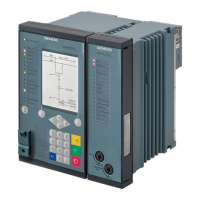[sc_para_hmi_oper, 1, en_US]
Figure 6-137 Menu Item for Parallel Control on the Device Display
Figure 6-138 shows an example of a CFC chart for switching to the parallel mode via the binary input of the
circuit breaker.
[sc_switchparop_cfc, 1, en_US]
Figure 6-138 CFC Chart
Master-Follower Method
As a prerequisite for the application of this method, the following values must be almost equal:
•
Transformation ratios of the used transformers
•
Number of the taps
•
Voltage differential between the taps
The Master-Follower method controls the Follower devices to the same tap positions as the Master trans-
formers. One voltage controller takes the lead (Master device), the other voltage controllers (Follower devices)
follow its tap position (Master-Follower method). The Master device controls the busbar voltage automatically
according to the same principles of the available voltage-controller functionality for a two-winding trans-
former. Compared with the Master-Slave method, this method has the advantage that losing a higher/lower
adjusting command (for example, due to communication loss or auxiliary-voltage failure of the Follower
device) does not result in asynchrony of the transformers.
The Master-Follower method is suitable for transformers of the same design. If transformers of different
power are controlled with the Master-Follower method, you must make sure that the same tap positions
result in the same ratios. The relative short-circuit voltages of the transformers must not deviate significantly
from each other (max. 10 %).
Control Functions
6.9 Voltage Controller
470 SIPROTEC 5, High-Voltage Bay Controller, Manual
C53000-G5040-C015-9, Edition 11.2017

